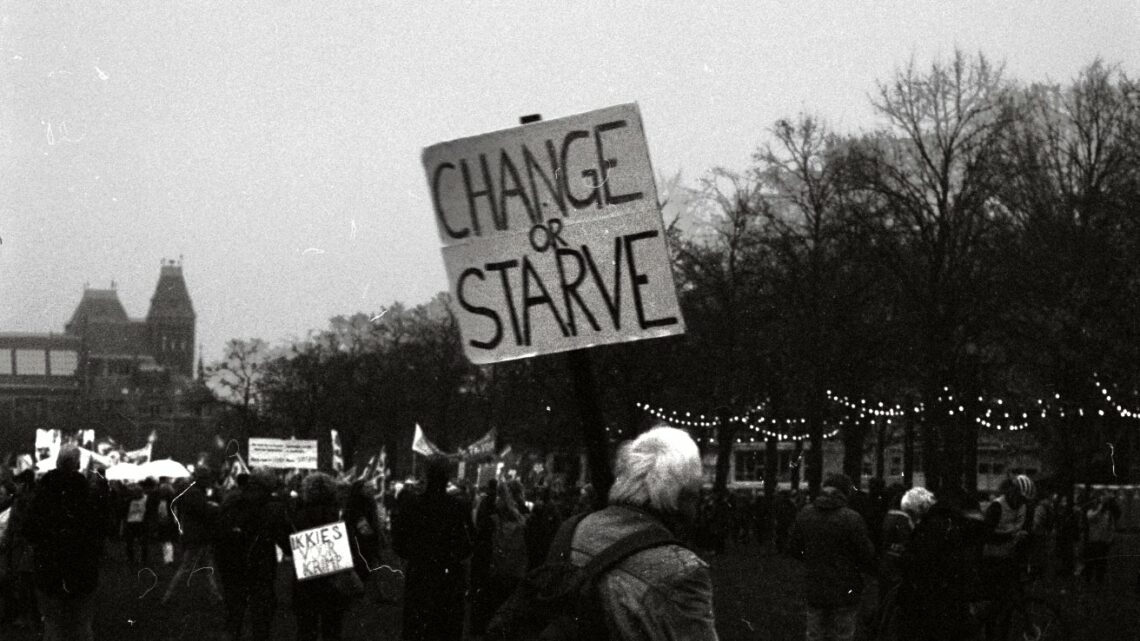New Far Right
Photo by Simon Ducos
The fact that history repeats itself is one of those empty sayings known to everyone. I say empty because it is both taken as an axiom and, at the same time, fundamentally disregarded. And so, one hundred years (give or take a decade) after fascism was sweeping across Italy, Spain and Germany, and almost exactly fifty years after Pinochet’s military coup in Chile, we are again witnessing an increase of far-right politicians in power[i]. The comparisons between them and their undisputedly fascist counterparts are endless – mostly to convince their current supporters that the ‘far’ part of ‘far-right’ is indeed needed. Who at this point has not heard Trump be compared to Hitler or Argentina’s newly elected president Milei to Pinochet? Some spare political analysts the trouble of having to find parallels on their own; with Italian PM Meloni calling herself a ‘post-fascist[ii]’ and members of the German AfD meeting with neo-Nazi groups to talk strategy[iii], these parallels are conveniently drawn by the politicians themselves. But maybe the reasons some people perceive these as valid political options, and not as a repetition of some of humanities darker moments, are not so unfounded. Both ideologically and in terms of style (which is an important part of fringe politics) it has departed from its previous manifestations[iv]. But what exactly are these differences? And why are they so successful in popularising far-right politics again?
What about war?
An obvious difference to point out, one that is frequently used to disregard any comparisons between older fascists and the new far-right, are the casualties. What is most known about past fascist regimes are the horrific homicidal campaigns they carried out. And the new far-right regimes have done no such thing to date. Nevertheless, this is not a difference I would like to focus on for three reasons. Firstly, the worst crimes against humanity in fascist regimes came after having been in power for a while so they are less important if we focus on baseline ideology and ascension to power. Secondly, a lack of crimes against humanity do not automatically absolve a person from being labelled far-right; they are merely the most extreme expression of extreme politics. Thirdly, even if we take for granted that no such atrocity could occur under current regimes (and there are valid reasons to assume this), the damage fascists caused extended beyond their violence; they shaped political cultures, validated hatred and undermined democratic norms and institutions[v].
Militarism
Already during the Second World War, German American philosopher Leo Strauss recognised militarism as an essential part of the extreme right position. He claimed that fascism in his time rejects principles of civilisation and replaces them with military ideals[vi]. This was apparent not only in the military campaigns that many of these extreme regimes carried out at the time, but also in the frequent portrayal of their leaders in military uniforms, using militant language and gestures and the emphasis on strict discipline.
In modern day far-right movements, elements of aggression are still present, but they are expressed in a decisively less militaristic way. There is more talk of protection and preservation, rather than taking an offensive stance. Far from being sworn pacifists — these leaders are still big proponents of the military and often increase its budget if they find themselves in the position of a ruling party, as was the case with Meloni[vii] and Trump[viii] for example. Even Milei, who announced budget cuts in basically every other area of state spending, promised the military and increase in budget from 0,6% of the GDP to 2% of the GDP[ix]. Nevertheless, the support of the military is seen more as a component of a powerful country, not as an ideal in the traditional far-right sense.
The new military campaign of the far-right is carried out internally. The most aggressive stance is taken against immigration, which is seen as the new biggest threat. Whereas previous fascists utilised the military to act against ideological opponents (i.e., communists), the current far right takes anti-immigration as a central part of their ideology. It can sometimes be the only connection between newer far-right movements that can differ greatly in their economic policiesv. European extremists, for example tend to be much more open to welfare policies than their North and South American counterparts, yet they are commonly seen as belonging to the same broader political trend.
The Past
Another component that is commonly associated with extreme right-wing politics is a glorification of the past. However, the current expression of this glorification is much stronger and better defined. The current past is more tangible; it is not far removed, simply a time reaching a few decades ago, before waves of mass migration and overly progressive politics. There is a clear goal of returning – the past does not need substantial changes.
The same cannot be said for the extreme right of the past. Although fascist regimes glorified the past, this past was much more mystical, unreachable. It served more as a national myth than a tangible template for how to organise contemporary society. On the other hand, fascist regimes were more concerned with the creation of a completely new world and a break with tradition, meaning a break with the mainstream way of doing things, developed in the century that preceded them. This is connected to fascist militarism; war was also seen as a process of purification, of destruction, of everything old that is bad and a creation of a new utopiaiv.
History Repeats Itself
These are some of the differences that can be pointed out to understand the new emergence of the far right and its popularity. But it in no way invalidates the comparison with previous fascism. Both trends developed in the way that they did because of the specific societies in which they were aiming to succeed. Extreme right politics nowadays are often labelled as populism, and with good reason. As Cas Mudde points out, populism is a thinly veiled ideology, meaning it can be applied to many different actual political stances, as long as it differentiates between a good ‘in’ and a bad ‘out’ group[x]. The ‘in’ and ‘out’ groups of now versus a hundred years ago are distinct, but the comparisons that are made when both trends are boiled down show the threat both pose, or posed, to democratic ideals and warn of the dangers extreme politics can bring about.
References
[I] Guriev, S., & Papaioannou, E. (2022). “The Political Economy of Populism”. Journal of Economic Literature, 60 (3): 753-832, Article 10.1257/jel.20201595.
[ii] Dosi, G. & Roventini, A. (2022). “The Leopard: How a Post-Fascist Party Rose to Power in Italy”. Intereconomics, 57(5): 270-271, Article 10.1007/s10272-022-1070-5.
[iii] Connolly, K. (2024). “Turmoil in Germany over neo-Nazi mass deportation meeting – explained” TheGuardian, Article https://www.theguardian.com/world/2024/jan/19/turmoil-in-germany-over-neo-nazi-mass-deportation-meeting-explained.
[iv] Antliff, M. (2002). “Fascism, Modernism and Modernity”. The Art Bulletin 84(1): 148-169, Article https://www.jstor.org/stable/3177257
[v] Down, I. & Han, K.J. (2020). Far right parties and ‘Europe’: societal polarization and the limits of EU issue contestation. Journal of European Integration, 43(1), Article https://doi.org/10.1080/07036337.2020.1728263.
[vi] Strauss, L. (1999 [1941]). “German Nihilism [lecture]”. Interpretation, 26(3): 353-378.
[vii] Ippolito, V. (2023). “Italy’s New Defence Plan: Nuclear Readiness Exercises, New German Tanks and Billions in Expenditures”. Finabel: European Army Interoperability Centre, Article https://finabel.org/italys-new-defence-plan-nuclear-readiness-exercises-new-german-tanks-and-billions-in-expenditures/
[viii] Macias, A. (2019). ”Trump signs $738 billion defense bill. Here’s what the Pentagon is poised to get”. CNBC, Article https://www.cnbc.com/2019/12/21/trump-signs-738-billion-defense-bill.html
[ix] Lambertucci, C. (2023). “Javier Milei’s proposals for Argentian: Economy, security, foreign policy and human rights”. El País International, Article https://english.elpais.com/international/2023-11-20/javier-mileis-proposals-for-argentina-economy-security-foreign-policy-and-human-rights.html
[x] Mudde, C. (2004). “The Populist Zeitgeist”. Government and Opposition, 39(4): 541-563, Article https://www.jstor.org/stable/44483088.
Simon Ducos is an Argentinian-born photographer in his second year of Communication Science at UvA. His interest in charismatic leaders and the decades of populist rule in his home country have turned his curiosity towards political communication, while journalism has long been his focus. Mainly working on film, Simon’s photography is driven by the analogue medium and processes. You can find him outside on rainy days appreciating the wonders of Dutch weather.


